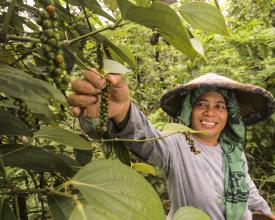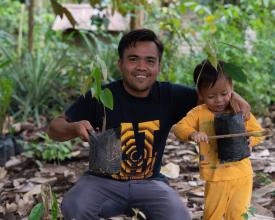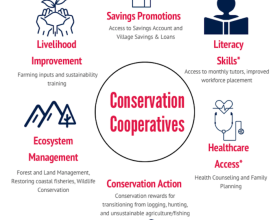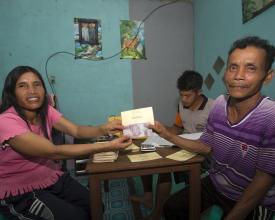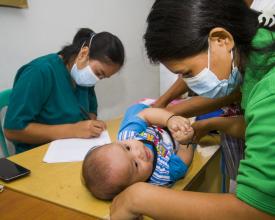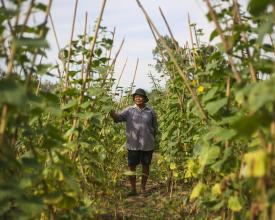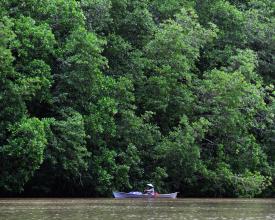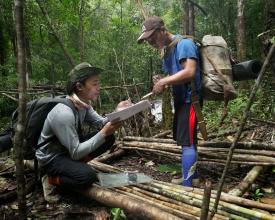Catalizar la conservación comunitaria para reducir la deforestación y la pérdida de biodiversidad mediante un enfoque ecosistémico integrado - Kalimantan Occidental, Indonesia
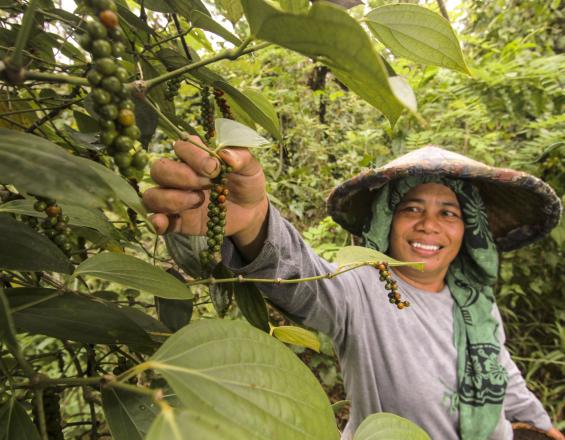
En Yayasan Planet Indonesia nos dedicamos a conservar los ecosistemas en peligro de la Tierra. En Indonesia, hemos sido pioneros en un modelo de conservación basado en la comunidad a través de nuestro modelo de "Cooperativa de Conservación" que aborda los factores subyacentes que causan la vulnerabilidad al cambio climático en nuestras comunidades asociadas. Creamos asociaciones lideradas por las aldeas para apoyar la adaptación basada en los ecosistemas (AbE) mediante el establecimiento de estructuras de gobernanza comunitaria (Cooperativas de Conservación) que permiten el acceso a servicios financieros y no financieros que catalizan la adaptación basada en la comunidad. Con nuestro premiado enfoque, creamos "Cooperativas de Conservación" (CC) para desarrollar vías que permitan a las comunidades rurales vulnerables superar los obstáculos a la adaptación al cambio climático. Al mismo tiempo, nuestro enfoque de CC crea AbE asegurando los beneficios para el bienestar (por ejemplo, medios de vida, salud) que los seres humanos obtienen de los servicios de los ecosistemas (por ejemplo, bosques, tierra, pesca, etc.), y facilita la forma en que estos beneficios pueden utilizarse para promover la adaptación al cambio climático.
Contexto
Défis à relever
Las comunidades rurales que viven en contacto con los ecosistemas de Kalimantan Occidental sufren a menudo inseguridades socioeconómicas debidas a necesidades sociales y financieras insatisfechas (Desafío socioeconómico). Estas barreras les empujan a explotar los recursos naturales circundantes más allá de sus necesidades de subsistencia, reduciendo la resistencia de los propios ecosistemas (Desafío Medioambiental) que actúan como su sustento. Como resultado, los bienes y servicios que estos ecosistemas proporcionan a las comunidades rurales corren el riesgo de colapsarse, eliminando así la línea de vida que sustenta los medios de subsistencia y el bienestar locales. A medida que las comunidades rurales agotan los recursos naturales de su entorno, se crea un bucle de retroalimentación positiva que agrava su incapacidad para satisfacer las necesidades básicas y financieras, lo que conduce a una mayor extracción de recursos que culmina en una espiral de pobreza. Esta explotación degenerativa de los recursos naturales atrapa a las comunidades en un círculo vicioso de injusticia medioambiental y reduce la integridad de los ecosistemas naturales de los que dependen.
Ubicación
Procesar
Resumen del proceso
Antes de establecer asociaciones en las aldeas para desarrollar estos "elementos básicos", escuchamos atentamente a la comunidad a través de audiencias y grupos de discusión. Estas audiencias y debates nos permiten comprender las necesidades específicas de la comunidad, sus retos y lo que las comunidades piensan que son soluciones a sus retos. Utilizamos esta información para desarrollar y adaptar nuestras actividades a las necesidades y soluciones planteadas por las comunidades locales. Así, hemos pasado de un enfoque "basado en la comunidad" a un enfoque "dirigido por la comunidad", lo que pone de relieve nuestro énfasis en la apropiación de las iniciativas a nivel local.
Una vez que las comunidades aceptan participar en las actividades del programa, creamos un "acuerdo de conservación" a nivel de aldea que destaca los aspectos clave de nuestra asociación con la aldea. A medida que los miembros se unen a su cooperativa, reciben acceso a una serie de servicios prestados en el marco de cada elemento constitutivo que aborda un aspecto diferente de las necesidades de los miembros de la comunidad.
Aunque cada componente no interactúa directamente ni depende de los demás, todos juntos tienen como objetivo abordar los factores subyacentes que causan las vulnerabilidades a las que se enfrentan los miembros de las comunidades de nuestras aldeas asociadas.
Bloques de construcción
Programa de Ahorro y Préstamo del Pueblo
Como parte de cada CC, ayudamos a iniciar y apoyar un programa de ahorro y préstamo dirigido por la comunidad (VSL) mediante capital inicial de puesta en marcha y formación financiera para los miembros del CC. El objetivo de nuestro Programa de Ahorro y Préstamo es desarrollar un programa de ahorro dirigido por la comunidad que permita a los miembros de los CC acceder a préstamos de baja carga y hacer frente al obstáculo que supone la falta de acceso a un capital financiero equitativo en el que puedan confiar los miembros de la comunidad para satisfacer sus necesidades de capital financiero. Como resultado, este programa permite a los miembros de la CC acceder a una fuente equitativa de capital que pueden utilizar para desarrollar y diversificar sus medios de vida y mejorar el bienestar de sus familias.
Una vez que el fondo VSL está operativo, los miembros del CC pueden solicitar un préstamo presentando una propuesta en la que describan cómo utilizarán los fondos y cuándo devolverán el capital, junto con otra información. En función de la propuesta y de sus méritos, el comité de préstamos del CC tiene autoridad para aprobar el préstamo al miembro solicitante. A medida que se devuelven los préstamos, se acumula una pequeña cantidad de los beneficios del miembro (1-5%) en el programa VSL gestionado por la comunidad, lo que le permite crecer y ser sostenible a largo plazo.
Factores facilitadores
Como piedra angular de cada CC y de nuestro compromiso con los miembros de la comunidad, proporcionamos un pequeño capital inicial para que cada nuevo CC establezca su programa de VSL a cambio de su compromiso de garantizar la gestión y el desarrollo del fondo. Otro factor facilitador clave es que los prestatarios utilicen los préstamos o una parte de ellos con fines productivos que les ofrezcan la oportunidad de mejorar sus medios de vida.
Lección aprendida
Hemos aprendido que reducir los costes de oportunidad a corto plazo de la conservación es extremadamente importante para despertar el interés por la gestión a largo plazo. Las VSL pueden contribuir a ello (i) ofreciendo acceso directo a incentivos a corto plazo, (ii) proporcionando seguridad financiera en tiempos de necesidad y (iii) fomentando la colaboración a nivel comunitario. Dado que las VSL dependen del ahorro y los préstamos colectivos, este mecanismo financiero puede servir de plataforma para debatir cuestiones más amplias, como la gestión de las zonas de conservación. Las reuniones mensuales con los grupos de VSL ofrecen importantes oportunidades para debatir cuestiones, mejorar la colaboración y crear plataformas participativas para la acción colectiva. Dado que la conservación eficaz dirigida por la comunidad suele girar en torno a un recurso común, estas reuniones periódicas, incentivadas a través de la VSL, son fundamentales para una gestión local equitativa.
Recursos
Programa Familia Sana
Formamos a mujeres y niñas locales para que se conviertan en embajadoras de la salud (AS) en sus comunidades y actúen como agentes de extensión de los servicios sanitarios públicos. Como parte de este programa, trabajamos con las oficinas sanitarias del gobierno local para mejorar el acceso a los servicios sanitarios, la salud de la comunidad y mejorar los derechos reproductivos de las mujeres a través de la extensión de los servicios sanitarios del gobierno en los pueblos asociados. Seguimos el enfoque Gente-Salud-Medio Ambiente (PHE) que pretende mejorar la salud de la comunidad a través de la promoción de la salud y mejorar el acceso a los servicios básicos. Una vez identificados los posibles HA, reciben una serie de cursos de formación impartidos por nuestro personal y 3 cursos adicionales impartidos por el organismo gubernamental pertinente. Una vez completada con éxito la formación, los asesores empiezan a realizar visitas semanales a los hogares de sus comunidades. Durante estas visitas, evalúan las actividades de cada hogar y proporcionan información sobre salud prenatal y posnatal, anticonceptivos, cuestiones de saneamiento, efectos del tabaco y nutrición. La información se proporciona mediante carteles y vídeos que se reproducen en los teléfonos inteligentes que llevan los embajadores de la salud.
Factores facilitadores
Los factores que facilitan la aplicación de este programa son la falta de acceso a tales servicios en la comunidad y la existencia de un vínculo entre la salud humana y la salud del ecosistema. Se necesitan audiencias o talleres comunitarios para poner en marcha esta intervención, ya que a menudo las comunidades desconocen las medidas de salud pública y no identifican la mala salud como un obstáculo para el compromiso y el bienestar de la comunidad. Hemos comprobado que esto suele ocurrir cuando las comunidades tienden a centrarse en medidas monetarias de la pobreza rural, en lugar de identificar la educación, la salud y otros indicadores de bienestar.
Lección aprendida
Se han aprendido varias lecciones importantes. En primer lugar, las iniciativas sanitarias comunitarias, cuando se aplican correctamente con una prestación de servicios de alta calidad, pueden ser esenciales para abrir la puerta a una mayor participación de la comunidad. Es difícil participar en la gestión de los recursos naturales cuando uno está enfermo o tiene familiares enfermos. Por lo tanto, mejorar la salud de los hogares puede abrir la puerta a una mayor participación en los programas comunitarios. En segundo lugar, las intervenciones de salud comunitaria son esenciales para crear relaciones positivas y confianza entre las ONG y las comunidades locales. Esto puede ayudar a crear asociaciones más sólidas, facilitar la colaboración y crear un espacio para conversaciones más difíciles sobre las interacciones socioecológicas.
Recursos
Programa de alfabetización
Nuestro Programa de Alfabetización crea acceso a la educación básica para nuestras comunidades asociadas, especialmente mujeres y jóvenes de zonas rurales, que carecen de la capacidad para completar su educación. Nuestro método de admisión evaluativa garantiza que los estudiantes se gradúen a través de nuestro programa de alfabetización en el menor tiempo posible con el fin de aprovechar las oportunidades de empleo y estudios posteriores. Contamos con el apoyo de organizaciones expertas en el sector educativo de Indonesia, como Pusat Kegiatan Belajar Masyarakat (PKBM). PKBM es una ONG indonesia registrada que imparte cursos de alfabetización y administra los exámenes nacionales del gobierno. Los estudiantes que aprueban el examen nacional reciben un certificado que les ayuda a encontrar trabajo y mejora su acceso a la población activa.
Como parte de este programa, también apoyamos la formación de tutores locales en colaboración con las escuelas públicas locales y PKBM. Al formar a personas locales para que se conviertan en tutores en sus comunidades, reducimos los costes para que los miembros de la comunidad accedan a la educación básica en comunidades de difícil acceso.
Factores facilitadores
Entre los factores clave que hacen posible este programa se incluye la voluntad de participar en él de los estudiantes locales que carecen de acceso a tales servicios. El diseño participativo (tanto del problema como de la solución) y la elaboración de mapas también facilitan este elemento. Mediante este ejercicio, los facilitadores pueden trabajar con los miembros de la comunidad para establecer vínculos entre las diversas barreras sociales y los resultados socioecológicos generales.
Lección aprendida
Al igual que otros servicios socioeconómicos descritos en nuestro enfoque, los servicios educativos son un importante punto de entrada y un pilar básico para crear relaciones positivas y saludables con las comunidades. También hemos aprendido que los servicios educativos y sanitarios parecen ser especialmente importantes para incentivar la participación de las mujeres en el plan general dirigido por la comunidad. Esto es esencial, ya que la conservación dirigida por la comunidad no puede lograrse adecuadamente sin la integración de la perspectiva de género.
Recursos
Programa de Agricultura Sostenible y Agroforestería
El objetivo de nuestro programa de agricultura sostenible y agrosilvicultura es mejorar la nutrición y fertilidad del suelo, regenerar las tierras forestales degradadas y garantizar la seguridad alimentaria. Como parte de este programa, formamos grupos de entre 15 y 20 agricultores de un CC que luego son tutelados por un agricultor líder seleccionado por sus compañeros y formado por nosotros. Esto nos permite compartir fácilmente información sobre técnicas mejoradas y maximizar el intercambio de conocimientos y el aprendizaje entre las comunidades agrícolas. Además, desde 2017, hemos ayudado a las comunidades a seleccionar y plantar más de 60.000 plántulas de especies autóctonas en las zonas de amortiguación de nuestros emplazamientos terrestres y a replantar estanques de acuicultura abandonados con 38.000 plántulas de manglar en nuestros emplazamientos costeros. Esto no solo garantiza la alimentación, la nutrición y el sustento de las comunidades de pequeños agricultores participantes, sino que también crea un hábitat y una conectividad cruciales para la vida silvestre, y genera servicios de regulación y aprovisionamiento.
Factores facilitadores
El factor clave que permite el éxito de nuestro programa de agricultura sostenible es la capacidad de demostrar los beneficios de la producción, tanto en términos de mayor rendimiento como de reducción de costes para los agricultores. Otras condiciones que posicionan esta intervención como un componente básico de nuestro modelo general de programa es la relación entre la producción agrícola y la deforestación. Este factor permite que la intervención esté bien posicionada para lograr resultados intersectoriales de mejora de la seguridad alimentaria, reducción de la deforestación y mejora de la seguridad económica.
Lección aprendida
Hemos aprendido que el estilo de graduación de un enfoque es extremadamente importante. A menudo, pedir a los agricultores que den saltos demasiado grandes en el cambio de su comportamiento puede resultar abrumador, desalentador y disuadir de la acción local. Un enfoque de graduación hace que el cambio de comportamiento sea "gradual" y recompensa a los agricultores por los pequeños pasos que se dan para alcanzar un objetivo general. Por lo tanto, a medida que los agricultores pasan del primer al segundo paso, van adoptando pequeños cambios (por ejemplo, cultivos intercalados, semiorgánicos frente a químicos), hasta que llegan al cuarto paso, que es un agricultor que se gradúa del programa. Esta ha sido una importante lección aprendida para nuestra organización.
Programa de Pesca Sostenible
Un componente clave de nuestro programa de pesca sostenible en nuestro emplazamiento costero es la intervención de "gestión participativa de la pesca" a través de la cual coimplementamos cierres periódicos de ríos. Diseñamos esta intervención a la luz de la preocupación de las comunidades por el colapso de las poblaciones de peces, cangrejos y camarones, que había provocado directamente una reducción de los ingresos familiares. Como este declive de las poblaciones de peces se debía a la falta de caladeros claros, a los conflictos entre aldeas y dentro de ellas, y a las altas tasas de entrada en los caladeros de pescadores emigrantes de otras zonas, propusimos la idea de un cierre del río de 3 meses de duración. Se eligió el cangrejo de fango como especie objetivo de las vedas fluviales, sobre todo por ser uno de los productos más valiosos para los pescadores artesanales y una especie de rápido crecimiento.
Antes de cerrar un río a la pesca, los pescadores de la comunidad utilizan un mapa de los ríos de su aldea para elegir la ubicación del río que se cerrará y decidir el momento del cierre. Lo único que no eligen es la duración de la veda, que se ha fijado en tres meses en consulta con expertos en cangrejos de fango. Una vez que los ríos se abren a la pesca, los pescadores artesanales pueden cosechar los beneficios gracias al aumento del tamaño de los cangrejos y de los rendimientos.
Factores facilitadores
Un factor que favorece esta actividad es la vigilancia de los ríos durante las vedas para disuadir y prohibir la pesca. Otro factor que puede aumentar el éxito de las vedas es elegir un lugar que sea un foco conocido de cangrejos del fango (o de la especie objeto de la veda).
Lección aprendida
Los cierres periódicos ofrecen a las comunidades costeras una técnica de gestión "fácil de entender" y "fácil de aplicar" que puede reportar rápidos beneficios. Además, descubrimos que las intervenciones sociales y económicas en las aldeas son esenciales para incentivar la participación de las comunidades de pescadores en estas técnicas de gestión. En cuanto a los beneficios imprevistos, los pescadores de cangrejos del fango explicaron que les ayudaba a "asegurar" sus caladeros frente a los pescadores emigrantes que vienen de otros pueblos a pescar en los ríos que rodean sus aldeas. Otro beneficio citado por los pescadores estaba relacionado con su gestión del tiempo. Durante las vedas periódicas, los pescadores podían dedicar su tiempo a actividades cotidianas distintas de la pesca del cangrejo de fango y concentrarse en desarrollar otras fuentes de ingresos para sus familias. Mientras que antes salían a pescar cangrejos de fango todos los días, lo que en realidad era una apuesta para ellos, ya que no estaban seguros de si capturarían suficientes cangrejos para pagar al menos los gastos relacionados con el combustible de sus embarcaciones.
Programa de patrullas SMART
Tanto en nuestras zonas terrestres como costeras ponemos en marcha unidades de patrulla SMART dirigidas por la comunidad que permiten a las comunidades y a los organismos gubernamentales proteger los ecosistemas conjuntamente. En nuestras zonas terrestres, identificamos, formamos y equipamos a los miembros de las comunidades locales para que utilicen la Herramienta de Seguimiento Espacial y Presentación de Informes (SMART) con el fin de proteger sus bosques junto con los guardabosques del gobierno. Los equipos están formados por 3 o 4 miembros de la comunidad, 1 funcionario del gobierno y 1 miembro del equipo de nuestro programa. Estos equipos realizan entre 7 y 10 jornadas al mes a lo largo de senderos generados por el software SMART basándose en datos históricos. Además de crear oportunidades para rastrear datos sobre encuentros con la vida salvaje, la herramienta SMART también permite rastrear incidentes de caza furtiva y otras actividades ilegales dentro de los bosques protegidos. En nuestro emplazamiento costero de Kubu Raya, las patrullas SMART se realizan en embarcaciones 3 días a la semana (12 días al mes). Estas fechas se eligen al azar para crear incertidumbre en los horarios de las patrullas.
Factores facilitadores
Las patrullas SMART dirigidas por la comunidad funcionan mejor en zonas donde las comunidades tienen derechos sobre un área de conservación o la cogestión de la misma. En nuestro trabajo en Kalimantan Occidental hemos aplicado las patrullas SMART tanto a las zonas de conservación comunitarias (bosques y pesquerías) como a la cogestión de zonas protegidas entre las autoridades de gestión gubernamentales y las comunidades locales.
Lección aprendida
Se han aprendido varias lecciones importantes. En primer lugar, los puntos de entrada a las patrullas SMART son extremadamente importantes. Para la mayoría de las comunidades del sur global es probable que se trate de un tema delicado, y los miembros de la comunidad pueden sentir que sus medios de subsistencia se ven amenazados por la creación de un equipo de patrulla. Hemos aprendido que un punto de entrada viable es plantear las patrullas SMART como una herramienta de gestión y protección que ayude a las comunidades a (i) mantener alejados a los forasteros que puedan estar robando sus recursos, y (ii) hacer cumplir los acuerdos de gestión participativa de la comunidad. En segundo lugar, las patrullas SMART requieren una curva de aprendizaje, por lo que recomendamos encarecidamente a las ONG que se aseguren de que cada equipo de patrulla cuente con un miembro del personal plenamente formado y versado que acompañe a las patrullas durante el primer año (o más). En tercer lugar, a la hora de poner en marcha esta iniciativa en zonas protegidas, es esencial reunir a los guardabosques gubernamentales y a los miembros de la comunidad en torno a las patrullas. De este modo se fomenta una sólida colaboración entre ambas entidades, esencial para la gestión a largo plazo de una zona protegida o de conservación.
Impactos
- Medio ambiente
Las tasas de deforestación se redujeron en un 56 % en los alrededores de nuestras aldeas asociadas en comparación con 2 años antes de la implementación de nuestro programa en la Reserva Natural de Gunung Niut, y el 77 % de la pérdida de cobertura arbórea tuvo lugar fuera de nuestras áreas de asociación. En nuestro emplazamiento costero, los manglares se perdieron a un ritmo de 56,7 ha/año antes del inicio del proyecto (2014 a 2017), que se redujo a 23 ha/año tres años después del inicio de la ejecución del proyecto (2018 a 2020).
- Social
Nuestra Iniciativa Familia Sana y nuestros Programas de Alfabetización abordan directamente las carencias de servicios sociales en nuestras comunidades asociadas. Hasta la fecha, hemos formado a 157 mujeres locales como embajadoras de salud en sus comunidades que realizan visitas domiciliarias y crean acceso a información y servicios de salud pública para las mujeres y niñas de sus comunidades. Desde 2017, de un total de 559 participantes en nuestro programa de alfabetización, 264 participantes han completado el curso, de los cuales 251 han aprobado el Examen Nacional (una tasa de aprobados del 95%) y han recibido un certificado reconocido a nivel nacional que les permitirá buscar oportunidades de empleo formal.
- Económico
En junio de 2021, había un total de 99.762 USD$ en activos en nuestro programa de Ahorro y Préstamos para Aldeas en 21 Cooperativas de Conservación en los 3 emplazamientos de nuestro proyecto. Durante el periodo del proyecto, los miembros de las CC habían obtenido un total de 45.859 USD en préstamos, con una tasa de reembolso de los préstamos superior al 90%.
Beneficiarios
Nuestros beneficiarios son las comunidades Dayak de Gunung Niut y Gunung Naning, y las comunidades costeras de pescadores no Dayak de los manglares de Kubu Raya.
Objetivos de Desarrollo Sostenible
Historia
Pak Jaka es pescador desde hace más de 20 años, pero es la primera vez que pesca cangrejos en Sungai Nibung tras la última veda fluvial de 3 meses. En la región de Kubu Raya, los aldeanos, con el apoyo de Yayasan Planet Indonesia, han establecido un sistema de vedas temporales para mitigar el agotamiento de las poblaciones de peces como parte de una misión de conservación más amplia.
Estos cierres temporales funcionan prohibiendo periódicamente la pesca y el uso de una zona durante meses determinados para permitir que la población se restablezca y madure. De este modo se garantiza que las generaciones venideras puedan contar con los recursos naturales, al tiempo que se implica a las comunidades en la conservación.
El día que los ríos se abrieron de nuevo a la pesca, Pak Jaka se levantó con el sol para colocar 50 trampas para cangrejos en el río de Nibung. Cuando saca la primera jaula del agua, falla. Sin embargo, en la segunda saca del agua un gran cangrejo y se le dibuja una sonrisa en la cara. Antes de la colaboración de Planeta Indonesia con el pueblo, la pesca sin restricciones había aplastado las poblaciones de cangrejos y gambas, que se reducían con cada cosecha. Pak Jaka afirma que los cangrejos y los ingresos son notablemente mejores en las regiones que practican estas vedas temporales. Ésta es la tercera veda periódica que se aplica en la aldea de Sungai Nibung.
